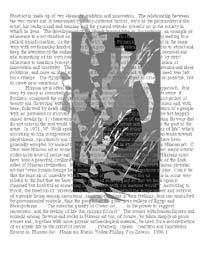

Tradition and Innovation
Minoan art is often considered a standard example of the opposite approach. It is seen by many as essentially innovative, a spontaneous expression of joie de vivre. F. Poulsen, compared the emergence of Minoan art with spring in Crete - a short period of beauty and flowering with the atmosphere filled with the fragrance of wild roses and with bees, followed by death and destruction. For him, Minoan art was the creation of a people with no problems or sorrows, by artists who did not bother to analyse nature but happily mixed details [p. 1] characteristic of one flower with those of another, creating flowers that do not exist in the real world but still show a sense of nature and rhythm on the part of the artist. In 1971, W. Wolf spoke of the "naive delight in the colorful splendor of life" which according to him is expressed in Minoan art, stating that "everything Minoan tends toward playfulness, spontaneity and fluidity". Such interpretations of Minoan art have been generally accepted by ancient historians and are found in standard works on Minoan art. C. Starr sees Minoan art as something "extraordinarily different from most other major artistic styles in its love of nature and lithe impressionism" and assumes that "the Minoans must have been a peaceful, civilized people", although he is not unaware of some of the dark sides of Minoan civilization. H. A. Groenewegen-Frankfort says about Minoan pictorial art that "even human beings here move with the joyous ease of creatures at play. Can it be that the faint air of unreality which so many of the figures have for us . . . is in some way related to the fact that we have lost the grace of serious play so that we look upon it charmed but doubtful as something incompatible with our maturer world"? According to Hood, the freedom of movement in Minoan art "may reflect the temperament and outlook of a people living among mountains, more independent in their feelings, less circumscribed by governmental controls, than the peoples of the great river valleys of Egypt and Mesopotamia . . . The essential quality of Cretan art, . . . is the power to suggest movement, and the feeling of life that springs from it." The scenes with human figures and animals among flowers and rocks in Minoan art can, of course, be taken simply as genre scenes and, together with more prosaic archaeological material, be used for a reconstruction of an idyllic life in the midst of nature. . . . [Walberg, Gisela. Tradition and Innovation. Essays in Minoan Art. Mainz am Rhein: Verlag Philipp Von Zabern. 1986.]
Copyright, 2000